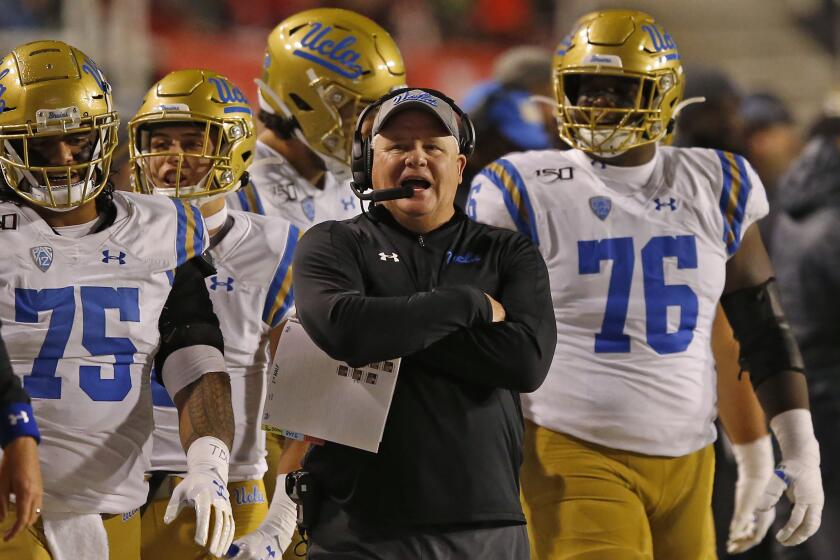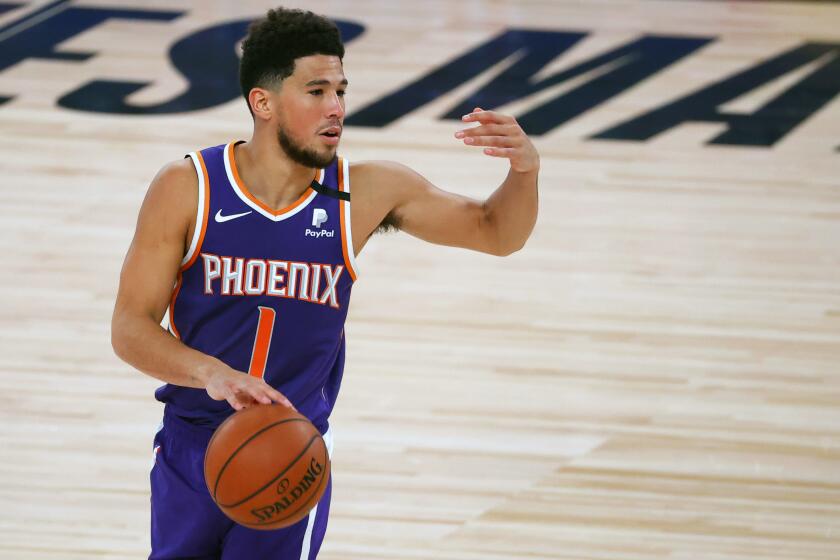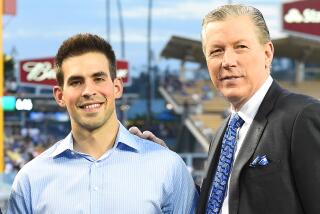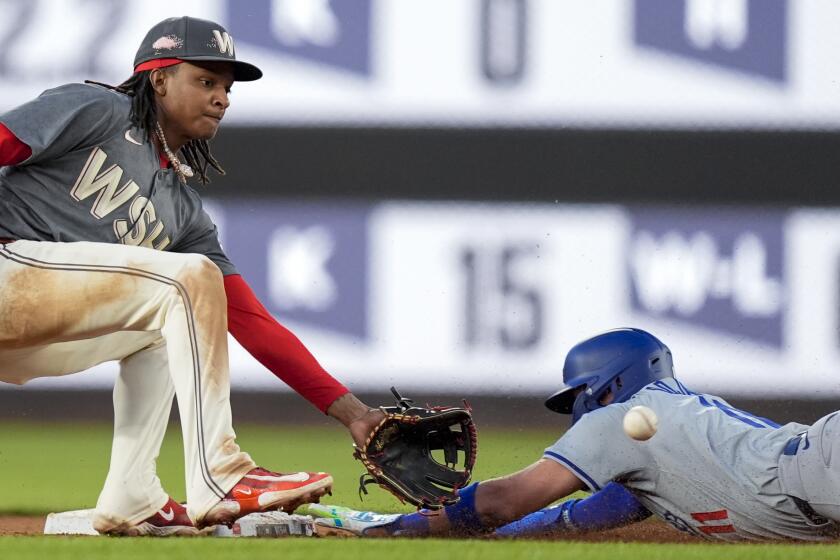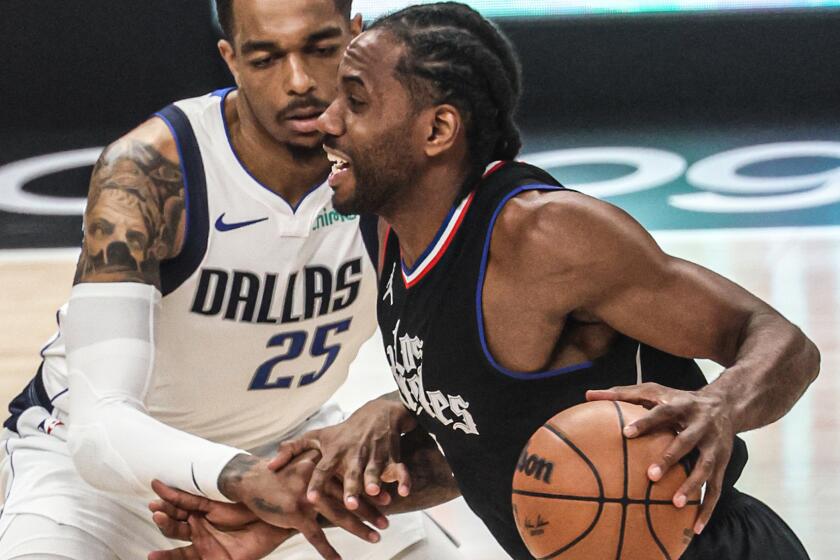In new era of sports consumption without fans, it’s all apologies for ‘potty mouths’
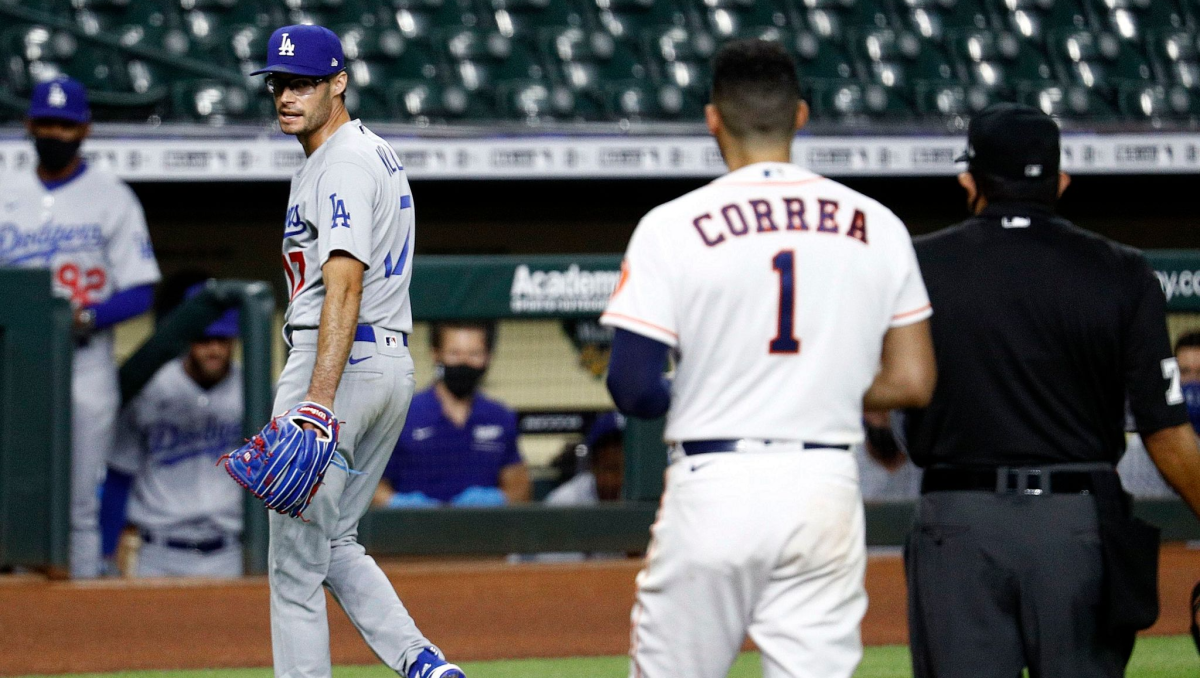
Last week’s Dodgers-Astros games in Houston were destined to feel like baseball as bloodsport. The disputed result of the 2017 World Series had led to three years of simmering tensions that reached a boiling point with the Astros being implicated as cheaters.
Dodgers play-by-play announcer Joe Davis was ready for anything. He had to be, given the surrounding circumstances that had nothing to do with baseball. He stepped into the booth at Dodger Stadium to call a game being played in Minute Maid Park, 1,500 miles away. And, if that wasn’t odd enough, the game would be played with no fans. How would this contentious reunion be received on television without the added buffer of 40,000 strong to absorb some of the raw emotion?
In the bottom of the sixth inning of the first game, a microphone picked up a gruff voice from the Astros dugout yelling to Dodgers pitcher Joe Kelly, “Get on the mound, motherf—!” Davis, who had no delay in his audio feed at Chavez Ravine, immediately responded, “Oooh, OK. So in empty stadiums, we pick up some things that we don’t normally pick up. Apologies for whoever the potty mouth is.”
The choice language reportedly came from Astros manager Dusty Baker. The next afternoon, it happened again. After the Astros’ Josh Reddick popped out, the player belted out the unmistakable F-word. This time, Davis kept it simple.
“Sorry,” he said with a mood-lightening tone.
Given how quickly Davis acted, a viewer easily could have assumed he had prepared for these scenarios. He hadn’t.
“I just try to react like a normal person would, and hopefully it’s a genuine reaction,” Davis said later. “With nobody in the stands, it’s so crystal clear. I never want to call attention to something like that, but if it’s so obvious, it’s the elephant in the room. People at home aren’t stupid. They heard it. It happened. Acknowledge it and move on.”
UCLA football coach Chip Kelly contracted the novel coronavirus in March and has since recovered after experiencing mild symptoms.
Fans never have felt as irreplaceable as during the COVID-19 pandemic sports restart. They are missed for more reasons than just their ambient noise helping to muffle obscenities and keep broadcasts PG. But from the moment sports shut down in mid-March, leagues and networks had to consider how to best capture their product without their No. 1 source of color and vibrancy.
Davis seemed blown away by the daily technological victories that brought baseball back to the masses, and he couldn’t wait to see what NBA games would feel like in the league’s Orlando bubble. He figured there would be plenty of “potty mouth” potential and wondered how much of that would make it onto the feeds from ESPN and Turner.
“Not that there’s not trash talking in baseball, but it’s pretty constant in basketball, just given the one-on-one nature,” Davis said. “But maybe it’s something you embrace. Obviously you don’t want a bunch of cursing with young kids watching the games, but if it’s a delay and someone can hit the drop button, maybe it’s something they can wrap their heads around.”
After about a week of games, NBA announcers haven’t had to apologize for anything slipping through. The court has never been so miked up, with 34 under the floor to pick up every bounce, step and sneaker squeak, but the league decided to go with a 10-second delay so that sounds that don’t fit the NBA’s desired image can be muted.
“We saw the opportunity along with the NBA to bring fans closer to the game,” said Mike Shiffman, a vice president for content strategy at ESPN. “We know fans love access, but we also respect this is the players’ place of work and that there is some privacy here in terms of, they’re doing their job and it’s highly competitive and very emotional and intense. It can’t just be a free-for-all of sounds.”

Said Steve Hellmuth, the NBA’s executive vice president for media operations and technology, “I always say to people, imagine if you had to wear a microphone for your entire day of work. How would that change your day in the office, right? We are protecting the players, no question.”
Desperate for live content in early May, ESPN began airing games from South Korea’s Korea Baseball Organization, which was playing without fans in ballparks. ESPN had to take a “world feed” with minimal control over the audio, which was being assisted with fake crowd noise.
“We were curious, then once we heard the game, it sounded quite authentic,” said Mark Gross, a senior vice president at ESPN. “Then there would be some hiccups in the feed where there was no crowd audio, and that’s where it was really hollow and quiet, and we really wanted that crowd audio back.”
The Korean league also afforded ESPN the chance to experiment during live games with commentators in different locations around the country.
The experience varied by sport. During an ESPN Top Rank Boxing event June 23, audio picked up the “N-word” coming out of one fighter’s corner. The announcer later apologized that the racial slur was broadcast and said Nevada Athletic Commissioner Bob Bennett addressed it with the corner. Fox Sports returned to live broadcasts with NASCAR and Major League Soccer.
With Blake Treinen throwing 98 mph, Kenley Jansen’s status as the Dodgers’ closer depends on his ability to adapt, columnist Dylan Hernández writes.
“What we realized real quick is that there isn’t going to be an all-sport solution,” said Brad Zager, an executive producer for Fox Sports. “With NASCAR, the cars and the radios and the driver communication really carry the broadcasts. We didn’t feel like not having the crowd there would lessen the viewing experience too much. We didn’t need to enhance it with crowd noise. In the MLS bubble, we did feel like we needed to enhance it.”
Fox worked with a company to strip audio from past broadcasts to mix into the current featured game with the ability to increase crowd noise at moments in the action that normally would coincide with more cheering.
The network decided to use that feature for its MLB games too.
“If we do see a heated moment or a moment between two teammates in the field, we can lower the crowd noise to pick up that natural audio on the field and then go back to the crowd mix,” Zager said. “We can pick and choose more than if the crowd is just there. In baseball, we haven’t had that moment yet, like, ‘Oh my God, there’s no crowd, I can’t believe we picked that up.’<TH>”
MLB games feature the usual organists and scoreboard sounds along with a crowd mix that is meant to feel just like home.
“It made it a little less eerie,” Davis said, “having some kind of buzz in there. I know people are split on this, having the weirdness of crowd noise with no crowd versus having no noise at all. The chatter you would hear would be cool, but I think it would be outweighed by how weird it all seemed with just dead silence.”
As ESPN began to conjure a plan for how to do basketball without fans, Shiffman said the only frame of reference came from a 2008 Southeastern Conference basketball tournament game that had to be moved from the Georgia Dome to Georgia Tech after a tornado damaged the dome. Still, the games at Georgia Tech allowed players’ families, school officials and 400 fans per school in the arena. Hellmuth has been preparing NBA arenas for broadcast audio since the mid-1990s. If there was ever someone who would relish this kind of challenge, it’s him.
Dylan Bundy throws the third complete game of his career — and the first for the Angels in more than two years — in a 6-1 victory over the Seattle Mariners.
“They’re not real NBA facilities because they lack a very important ingredient: fans, right?” Hellmuth said. “What fans get to sit as close to the field of play as NBA fans? Think about the NFL, baseball or soccer, they’re all greatly removed from the field of play, and our fans are courtside. So it was really a dramatic difference for us.
“Audio is our biggest issue, No. 1, because the pictures were all kind of in our own hands — where to put the cameras, how to light the courts, that’s something you can manipulate and very precisely determine. But audio is something resolved around the character of the building and its acoustical properties.”
Hellmuth said the NBA had gained helpful perspective by trying some new technology during summer league games the last few summers. Staging 33 scrimmages in a week before the season restarted allowed for the league to make sure it struck a balance between bringing fans close and protecting player privacy.
As the NBA sorted through how it wanted to use in-arena noise, there were a few games almost devoid of ambient crowd sounds, which made hearing players easier for everyone — for other players, for reporters and for referees. It meant that when LeBron James, often the loudest voice in the building, told his Lakers teammates that Orlando Magic guard Michael Carter-Williams was “all drive, no shoot,” every person in the gym heard the insult. He was telling his teammates how to defend Carter-Williams who, in James’ estimation, wasn’t a threat to score.
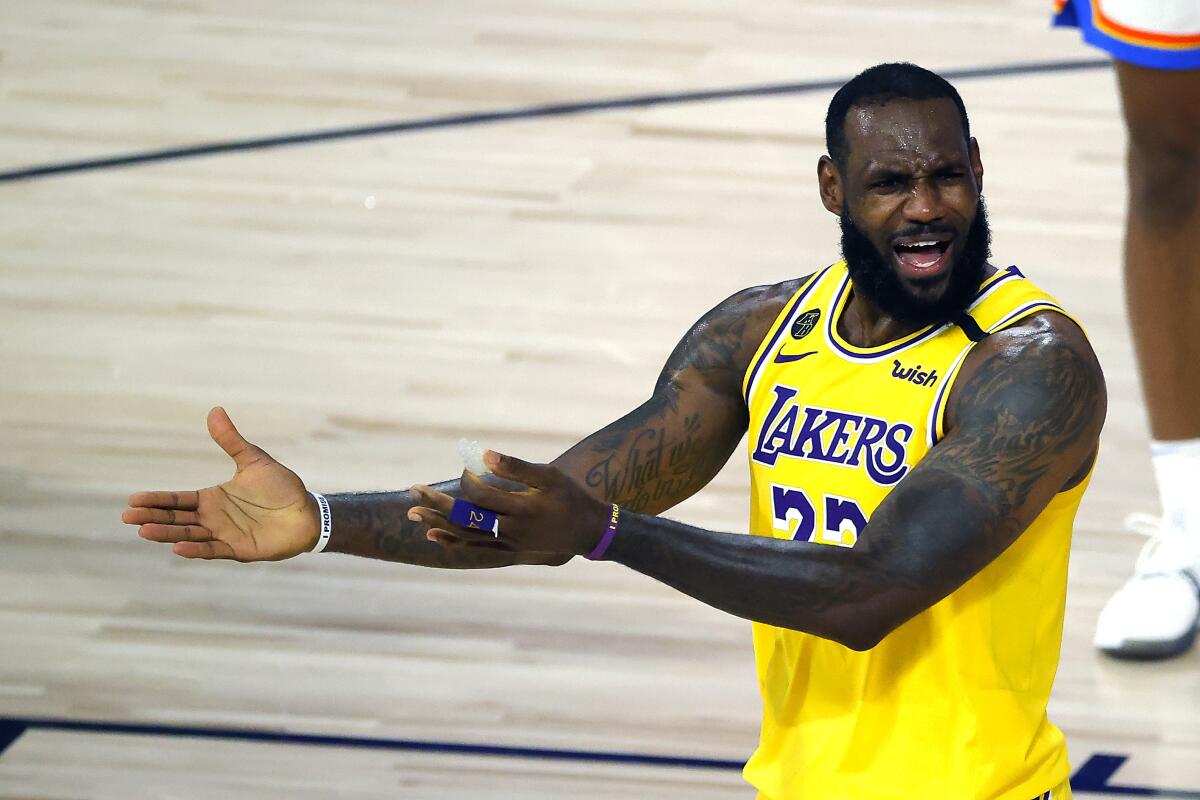
At another point, James gleefully chanted from across the court when he saw Anthony Davis with his back up against a young, overmatched Magic player five inches shorter than him. His team joined in the chorus.
Later that game James outran everybody on the court to score and declared, “Still the fastest man out here.”
For a while, James was able to loudly bark out defensive coverages for his teammates, both while he was on the court and while he was off it.
But even after crowd noise was added into the arenas, there was only so much it could cover up. Foul numbers have gone up and some players have attributed that to referees being able to hear them better. James was hit with a technical foul during the Lakers’ loss to Oklahoma City this week while he was sitting on the edge of the bench, as far away from the officials as he could be.
The Phoenix Suns were the last team in the Western Conference granted access to the NBA’s bubble, and Devin Booker has led them into the playoff conversation.
Now that the NBA has settled in, Hellmuth’s favorite aspect of the broadcasts so far are microphones attached to the backboards that are aimed to pick up reactions from the bench and a “rail cam” that sits where courtside seats normally would be and moves with the action from baseline to baseline.
With that, the NBA actually took advantage of not having fans in primo real estate.
“We obviously love the extra clear angles we have because of the fact fans aren’t there,” Shiffman said, “but we wouldn’t trade fans for anything.”
Times staff writer Tania Ganguli contributed to this report.
More to Read
Get our high school sports newsletter
Prep Rally is devoted to the SoCal high school sports experience, bringing you scores, stories and a behind-the-scenes look at what makes prep sports so popular.
You may occasionally receive promotional content from the Los Angeles Times.

